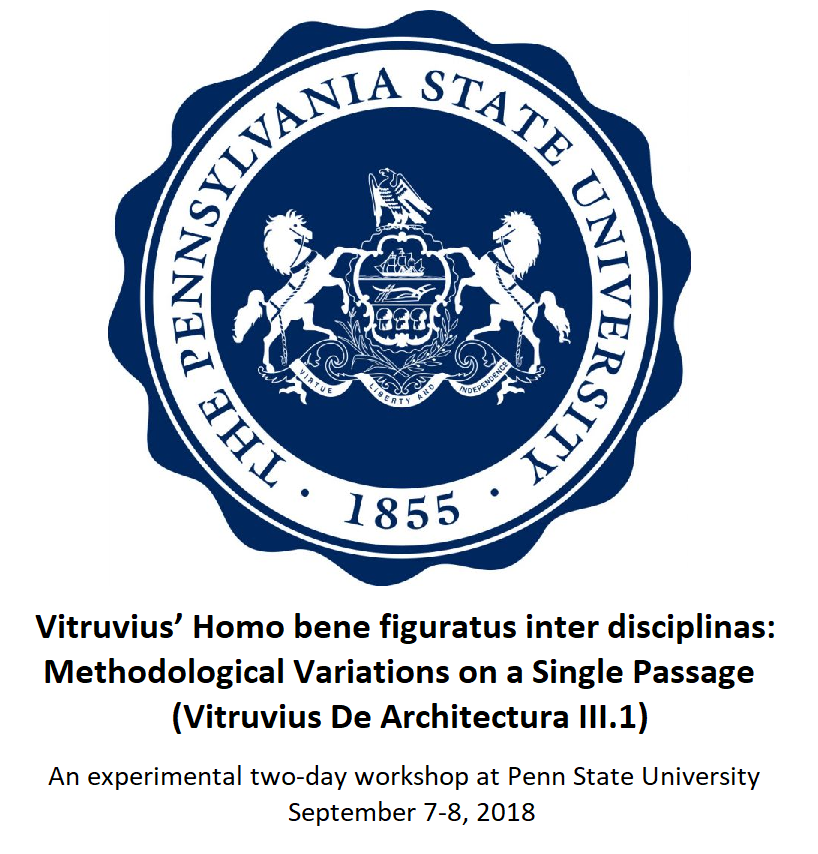CALL. 30.04.2018: Vitruvius’ Homo bene figuratus inter disciplinas: Methodological Variations on a S
- fasticongressuum

- 24 mar 2018
- 2 Min. de lectura

FECHA LÍMITE/DEADLINE/SCADENZA: 30/04/2018
FECHA CONGRESO/CONGRESS DATE/DATA CONGRESSO: 07-08/09/2018
LUGAR/LOCATION/LUOGO: Penn State University (State College, PA, USA)
ORGANIZADOR/ORGANIZER/ORGANIZZATORE: Mathias Hanses (Penn State); Giovanna Laterza (Heidelberg); Elena Giusti (Warwick)
INFO: call - mhanses@psu.edu - giovanna.laterza@uni-heidelberg.de - E.Giusti@Warwick.ac.uk
CALL:
In April 2016 a Fixed Handout Workshop was held at the University of Cambridge. Its aim was to encourage early-career Latinists to reflect on the impact that their varying academic influences and different methodological preferences have on the research they produce. In particular, the workshop tested the strengths and limits of each scholar’s intertextual practice. The participants delivered papers that were based on a pre-arranged selection of thematically connected passages, yet although several groups were presented with identical sets of Latin quotations, the papers they produced—and additional texts they adduced—varied widely.
The present workshop aims to continue this exploration of interpretative methodologies in a slightly altered format. We invite Classicists and scholars from other disciplines(especially Renaissance Studies, Art History, Philosophy, Architecture, Mathematics) to each present a paper on the same passage, but to use a different, clearly stated methodological approach. By asking scholars from different schools-of-thought and disciplines to focus their attention on a particular moment in Latin literature, we aim to:
a) measure the interpretive impact of different methodologies within the field of Classics;
b) explore how texts take different shapes under the lens of disciplines outside the Classics;
c) test in concrete terms the interpretative potential of an interdisciplinary dialogue.
The passage we have selected for the workshop is Vitruvius’ De Architectura III.1. While discussing the role of symmetry in the composition of temples, Vitruvius introduces the image of a well-formed human being (ad hominis bene figurati membrorum exactam rationem), from which proportional relations and principles of good measure are derived. The passage was famously the basis for Leonardo da Vinci’s interpretation of the “Vitruvian Man”, and continued to attract the attention of early modern exegetes and contemporary architectural specialists alike. With its textual, visual, philosophical, and scientific features, De Architectura III. 1 has an obvious and distinct interdisciplinary potential.
We are looking for speakers to deliver a methodologically informed reading of this Vitruvian chapter and/or its reception. We have six confirmed invited speakers (listed below), and we now invite applications for six more papers, especially (but not solely) from early-career researchers and finishing graduate students in Classics, Archaeology, Philosophy, Renaissance Studies, Art History, Architecture, and Mathematics.
If you wish to be considered as a speaker, please provide
1. An abstract on De Architectura III.1, stating explicitly the approach that you wish to take;
2. A brief cv;
3. A list of 6 major academic and cultural influences, both from within and from outside your field.
Send these items (preferably in pdf format) to homobenefiguratus@gmail.com by April 30, 2018. Decisions will be made by mid-June. Accommodation will be provided at Penn State for the nights of September 6 and 7, but we regret that speakers will be expected to cover their travel expenses. We aim to publish the contributions in a collected volume.



Comentarios